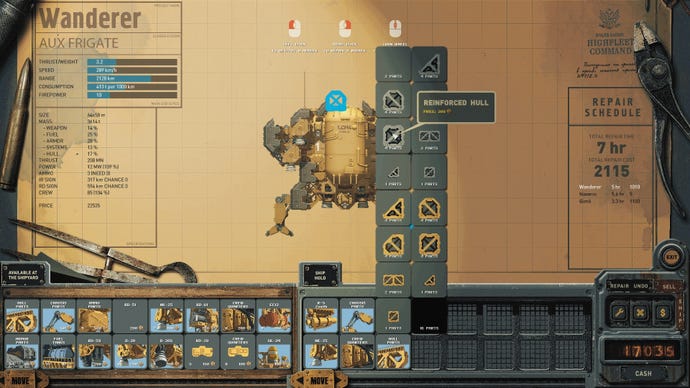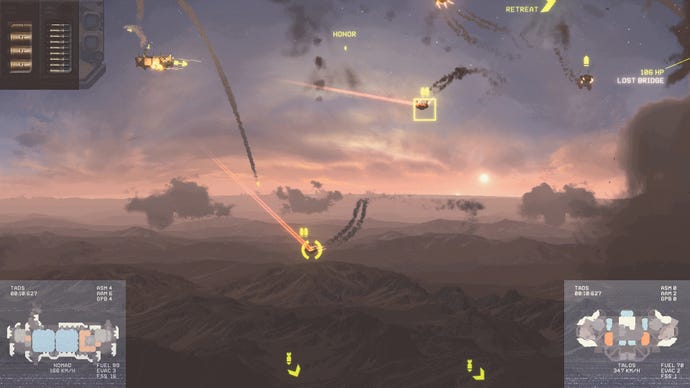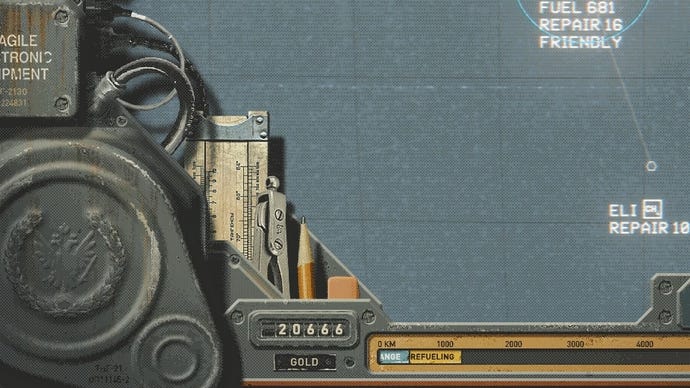Preview: HighFleet is a massive, smoke-belching slab of air combat which somehow keeps itself in the sky
Bruising for a cruising.
There are some game traits which you will know, if you have read a moderate number of my posts, are surefire Nate-bait. Settings which go big on the stark, WW1-evoking side of the “dieselpunk” identifier? Yes please. Bafflingly utilitarian, diegetic UIs covered in clunkers and switcheroos? Like and subscribe. Baroque, crypto-feudal science fiction cultures, where archaic royal houses persist in the middle of mechanised warfare on a chilling scale? Here’s my credit card number.
HighFleet - which is slated to come out in Q2, so sometime in the next few months - plots a course straight through this maelstrom of tropes, and comes out in a blaze of glory. And, admittedly, in a blaze of fire. But in a good way. Mostly.
The game puts you in the shiny shoes of a young duke and a scion of empire, sent to command a squadron of gigantic steel airships in the suppression of a distant rebellion. It all feels a lot like the Soviet war in Afghanistan, albeit with a distinctly more pre-1917, Jakub Różalski vibe to the occupying force, and a big bucket of Dune tipped over the lot. It’s great; I will drink this stuff up whenever it is put in front of me. In fact, if you ever read an old comic called The Red Star, you’ll find HighFleet has a lot of shared notes in the right places, but without a lot of the fist-in-mouth hamminess which TRS suffered from.
And how do you go about prosecuting this war? Well, you had to go and fucking ask, didn’t you?

I’m sorry I swore at you. It’s not your fault. It’s just that HighFleet is one of those games which makes itself a headache to categorise, by its insistence on weaving six or seven disparate formats together. If I had to be reductive, I’d say it felt like The Banner Saga, but with the occasional turn-based fights replaced with inertia-laden, side-on dogfights between brutish airborne cruisers.
Don’t make me be reductive, though; I beg you. Because HighFleet is also a fleet management game, a relatively freeform RPG, a sandboxy warship construction sim not unlike Nimbatus, and a survival game. It briefly lurches into drag as a card game about political speeches from time to time, releases the occasional album as a dexterity-challenging radio espionage simulator, and routinely drops everything to become an utterly gorgeous, if repetitive, game about landing knackered juggernauts in wartorn desert cities.

None of it’s rubbish at all. Almost all of it is brilliant. But my goodness, does it have a lot of moving parts as a result. And they must all be attended to, laboriously, in order for progress to be made. HighFleet never lets you skip leg day. Or refuelling day. Or course charting day. Or buying-new-missiles-one-at-a-time-from-a-gas-hooded-merchant-in-a-beautifully-rendered-stock-room day, for that matter. All of these activities are a pleasure, in themselves, but they work against each other in terms of the overall flow of the game.

Take the shipworks interface as an example. Here, one can painstakingly re-outfit and even rebuild ships, down to the last square of hull plating. So far as I’ve seen, the system is flexible enough that the tiniest corvette could be built up into a sky-quaking leviathan over successive refits, through the gradual accretion of new spars, tanks, thrusters, crew quarters and armour plates. Warships can be fine-tuned to take every advantage of HighFleet’s outstanding battlefield physics, in a way that makes you feel as much a rocket scientist as an admiral.
But then, come the actual battle, a fit of poor performance can see all of that work turned to red-hot shrapnel in an instant. I am, it turns out, a better ship designer than I am a pilot, and HighFleet’s battles can be pretty unforgiving.
The ease with which ships can be lost bites both ways. Knowing I could lose all my work in an instant makes me reluctant to tinker with ships. And when I have tinkered with them, I’m ineffectively timid with them when they enter the fray. I know that’s actually a pretty obvious bit of realism, there. But then, I don’t actually want to be as stressed as a real admiral. I want to lean right in to the thuggish, lurching, splendidly tactile clatterthud of battle and have a good time.

Similarly, the radio minigame. You spend a lot of time as a captain doing navigation, charting your course over the arid wastes of Gerat. You’ll be planning assaults on enemy positions, rendezvouses with allied forces, and resupply stops at occupied cities. But all the while, you’re being hunted by hard-as-nails enemy strike formations, which you evade by intercepting enemy comms.
"HighFleet would be more fun if it wasn’t so bloody well designed, which is a sentence that makes my soul hurt to type."
This is done via twiddling on-screen knobs and listening to R2D2 noises under time pressure: the quicker you lock down the transmission, the more of the message you get. Once again, this is really, really good stuff. But if you sod it right up and run into the enemy fleet, you can have your ghosts thoroughly busted, and everyone’s going to end up eating hot dust for tea.
As with the interplay between ship design and combat, here’s a case where your investment in one game system can be instantly and devastatingly undermined by your failure in another, wildly different system. If they weren’t all neatly chain-mailed into each other, so that every action you took affected every decision you would subsequently make, it wouldn’t be so bad. In other words, the game would be more fun if it wasn’t so bloody well designed, which is a sentence that makes my soul hurt to type.

I’m only a few hours in to HighFleet. But tellingly, those hours have been spread pretty evenly across several restarts, which were less ragequits and more not-angry-just-disappointedquits, where I suddenly realised what a silly mistake I had made. My hope is that as I press on, the game starts to give me reasons not to get so stressed about making mistakes. My fear, however, is that I won’t stay with it long enough for that to happen, for fear of… making mistakes.
Regardless of that, this is a solid recommendation from me. I suspect that, for someone with a more exacting, calculating temperament (not to mention better piloting skill), this could be a smash hit. Even for someone who suspects they are prone to the same sort of paralysis I’ve described myself falling into, I’d still urge a purchase based on the atmosphere alone, not to mention the visuals. HighFleet might be too weird to live, but it’s certainly too rare to die.





